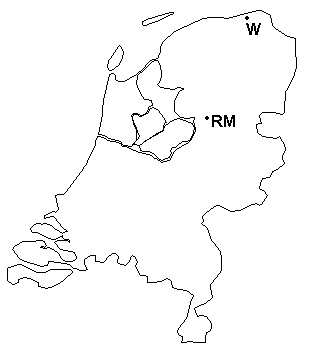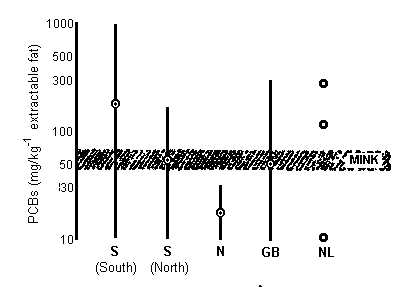 |
Last Update:
Friday November 23, 2018
|
| [Home] |
|
Volume 2 Pages 1 - 58 (March 1987) Citation: Broekhuizen, S. (1987) First Data on Contamination of Otters in the Netherlands. IUCN Otter Spec. Group Bull. 2: 27 - 32 First Data on Contamination of Otters in the Netherlands Sim Broekhuizen Research Institute for Nature Management, Kemperbergerweg 67, NL-6816 RM Arnheim, The Netherlands. In the last decades otters became rather rare in The Netherlands. Consequently, during the last years only a few otters that were found dead became available for scientific examination. Recently, the chemical department of the Research Institute for Nature Management analyzed liver and kidney tissue of three otters:
Tissues of kidney and liver of all three otters were examined for the heavy metals lead (Pb), cadmium (Cd), mercury (Hg), copper (Cu) and zinc (Zn) and for polychlorinated biphenyls (PCBs) . Kidney and liver of the otter found dead in 1986 were also examined for chlorinated hydrocarbon pesticides. The results are summarized in tables 1, 2 and 3. PCBs were detected by gas chromatography with capillary columns, but in 1986 otter PCBs were also detected by gas chromatography with packed columns. The latter method has been used in most otter analyses published up to now.
Looking at the data, attention will be caught by the figures of PCBs. To compare these data with those from other European countries, the mean values of table 2 are fitted into figure 2, obtained from Mason and Macdonald (1986) and based on data from Olsson et al. (1981), to which data from Great Britain (Mason et al., 1986) were added. The wide variation in concentrations also occurs in the Dutch material. The cause of this variation is unclear, as the animals with the lowest and the highest concentration both originated from the same area and the hydrology of that area has not changed essentially during the last years.
In the first-year male from 1986, in which the highest concentrations of PCBs were found, a walnut-sized tumour was found at the back side of the liver, while in one of the kidneys a coral-shaped renal calculus was found (Broekhuizen, 1986). This animal was in a poor condition, without any fat deposit, and had actually died of pneumonia. In the other two otters no abnormalities were recorded. Since, in two out of the three analysed otters, PCB concentrations in extractable fat exceeded significantly the minimum concentration causing reproductive impairment in experimental mink, and these two otters originated from non-industrial areas, it seems possible that PCB pollution contributed significantly to the decline of the Dutch otter population during the last decades. However, the low PCB concentration found in the lactating female shows that the situation is not that simple. As the otter with the highest PCB concentration was in a very poor condition, without any fat deposit, the very high PCB concentration in extractable fat in this animal could be mainly the result of the exhaustion of the fat reserves. As to the chlorinated hydrocarbons and heavy metals, the detected
concentrations do not seem very alarming, although we have hardly any
information about synergistic effects of the different chlorinated
hydrocarbons, PCBs and the biologically non-functional heavy metals, and
little is known about the toxicology in European otters. The high
concentrations of copper and zinc seem quite normal. These are
functional elements in the metabolism of the animals and they have
mechanisms to regulate these concentrations. |
||||||||||||||||||||||||||||||||||||||||||||||||||||||||||||||||||||||
| [Copyright © 2006 - 2050 IUCN/SSC OSG] | [Home] | [Contact Us] |

